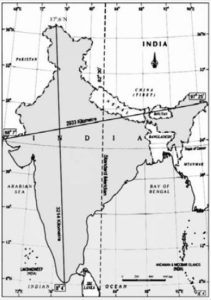10th Class Social Studies – CCE Pattern
(4 Marks Questions – India – Relief Features)
Q: In what way the Himalayas are influencing the Indian Climate and in turn how this influencing the Indian Agriculture? Describe.
A: The Himalayan ranges run in the west – east direction in the form of an arch with distance of about 2400 km. They are useful to mankind in several ways.
They act as barriers protecting the great plains of India from the cold winds of central Asia during severe winter. This helps Indian Agriculture to cultivate many varieties of crops.
They are caused for summer rains and monsoon type climate in regions that are beyond the western ghats of India.
If there is no evergreen forests in Himalayas, there may be uneven environmental conditions and severe temperatures recorded.
Himalayas serve water for irrigation being the birth places of perennial rivers.
This region is suitable for construction of multipurpose projects which strengthens the Indian Agriculture.
The sediments carried by the Himalayan rivers are deposited in the northern plain in the fertile soil.
The Himalayan slopes suitable for terraced cultivation. Thus, the Himalayas are influencing climate and agriculture of India.
Q: What are the relief divisions that you have to observe to understand the Indian landmass? Describe them.
A: The relief divisions of Indian landmass can be divided into the following groups:
The Himalayas: The Himalayan ranges run in the west – east direction in the form of arch with a distance of about 2400 kms. The formation of the Himalayas influences the Indian climate and agriculture in various ways.
The Indo – Gangetic Plain: The interaction of the three Himalayan
rivers, Indus, Ganga and Brahmaputra and their tributaries resulted in the formation of great northern plain. In the beginning it was a
shallow basin that was gradually filled with varied alluvial soil that these rivers brought from the Himalayas.
The Peninsula Plateau: It is surrounded by the sea on three sides.
It is mainly composed of the old crystalline, hard igneous and metamorphic rock. The topography of the plateau is slightly tiled
towards east and the western and eastern ghats form the western and eastern edges respectively.
The Coastal Plain: The southern part of the peninsular plateau
is bordered by narrow coastal strips along the Arabian sea on the west and the Bay of Bengal on the east.
The Thar Desert: It is located on the leeward side of Aravalis
and receives very low amount of rainfall, ranging from 100 to 150 mm per year.
The Islands: There are two groups of Islands – Andaman and Nicobar Islands stretched in Bay of Bengal and Lakshadweep Islands in the Arabian sea.
Q: When compared to the Gangetic Plains the Deccan Palteau is not suitable for Agriculture. Why?
A: Indo-Gangetic Plains is formed by the Himalayan rivers, Indus, Ganga and Brahmaputra and their tributaries. It was gradually filled with varied alluvial soil brought by these rivers. So as, it is more
suitable for Agriculture than Deccan Plateau.
Gangetic plains are formed with alluvial soils which are very fertile, so support agriculture.
Gangetic Plains have perennial rivers, whereas Deccan Plateau region doesn’t have any perennial river.
Plains had thick forest and rich variety of wild life. So here, large part of agricultural activities are done.
Plateau region is rich in minerals whereas plains are rich in agricultural practice as most of the people takes agriculture is
their occupation.
The rugged surface of plateau makes irrigation difficult whereas plains provide much irrigation facilities.
In comparison to the Gangetic plains, the plateau region is dry as rivers are not perennial. The irrigation for the second crop depends on deep tube wells and tanks.
